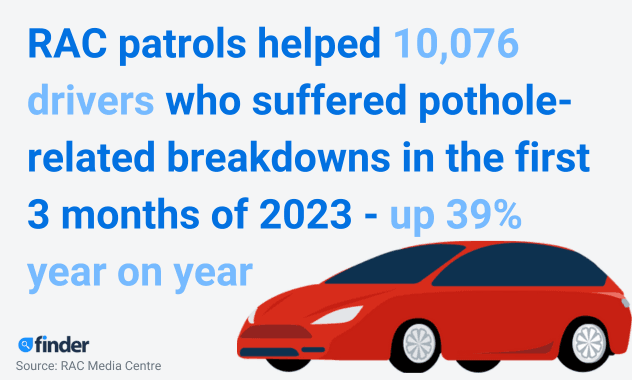
Breakdown cover could help you save in the long run if you ever find yourself stranded on the open road. Use the table filters below to compare the different types of breakdown cover, policy providers and prices that would suit you. Table sorted by: promoted deals.
What is breakdown cover?
Breakdown cover is a type of insurance that protects you from getting stuck on the roadside if something were to happen with your car, like a flat tyre or a mechanical fault. Breakdown cover typically includes roadside repairs and, in cases where your car can’t be fixed, the option to have it towed to a nearby garage.
Breakdown cover jargon explained
Home start. Also known as home rescue or at home breakdown, home start is a type of cover that only applies if you breakdown within a limited radius of your home.
Onward travel. Where your car can’t be fixed, onward travel covers you to continue your journey by alternative means or compensation for additional expenses.
How to compare breakdown cover
There’s no such thing as a one size fits all breakdown cover policy as your personal circumstances will dictate the cover you need. Follow the steps below to help find the right policy for you:
- Start by researching regular car insurance. Some car insurance policies automatically include breakdown cover and you might find a great deal at this stage. Otherwise you’ll need to buy breakdown cover as a separate policy or optional extra.
- Shop around. The best way to get the best deal on breakdown cover is to compare as many policies and providers as possible. Some providers will offer price matches on lower premiums you find online. When your policy is up for renewal, it’s worth shopping around again as you might find an even better deal and switching could get you big savings.
- Use autofill to save time. Simply switch this feature on in your chosen web browser. If you want to review your quotes, or make small changes to your form, you can also do so by accessing the Finder quote email and clicking “Edit quote details”.
- Make sure your details are correct. Seemingly minor details like your age, location, occupation and marital status can have a major impact on the cost of your cover, so make sure you input the correct information to ensure you get an accurate quote.
- Balance your cover needs with a reasonable price. There’s no such thing as the perfect policy, the key is to find a happy medium between the price and the level of cover that suits your personal circumstances.

How can I save money on my breakdown cover?
There are a couple of ways you can save on your breakdown cover before you sign on the dotted line. To get the best deal, heck out our three handy tips:
- Age of your car. If your car is brand new, it might be worth opting for a more basic form of cover for the first couple of years. With a new car you’re less likely to need the full works. If your car is relatively old, then it might be time to think about increasing your breakdown cover. Unfortunately, many insurers don’t offer breakdown cover for cars older then 15 years old, but make sure to shop around if this is what you require, as some companies might offer it.
- Check your car insurance policy. You might find that your car insurance policy already includes breakdown cover so you don’t need to spend the extra cash. But it is important to check what is included within this cover, as you may find it only covers the basics.
- Joint policy. Often it can be cheaper to buy a joint or family policy if you have more than one driver in your household, rather than individual policies for each person.

What types of breakdown cover are there?
There is nothing worse than needing a tow and realising your breakdown policy doesn’t cover you for it. There are different types of breakdown cover out there so make sure you understand what you’re signing up to.
There are typically five types of breakdown cover available:
- Roadside assistance. This is the most basic form of breakdown cover and should be included within all breakdown policies. Roadside assistance ensures that if your car breaks down further than a quarter of a mile from your home, someone will be sent to assist you on the road. If your car cannot be fixed on on the roadside, it will typically be towed to a nearby garage.
- National recovery. Also known as vehicle recovery, this type of cover is the level up from roadside assistance. National recovery means that, if your car can’t be fixed on the roadside, it can be towed to any location of your choice within the UK.
- Home start. This provides you with cover should your vehicle break down at home or very near to it (usually within a quarter of a mile to a mile radius of your home). Home start cover is sometimes called at home recovery or at home breakdown.
- European cover. As the name suggests, this type of cover protects you on the roads when you’re driving in Europe.
- Onward travel. If your car can’t be fixed on the side of the road, then having onward travel cover means that you will be offered a way to continue your journey. Some companies offer to reimbursed you for public transport costs, pay for an overnight hotel stay or offer a replacement car hire while yours is being repaired.
Carry out a few basic checks to make sure your car is ready for when you need it. Don’t leave it until your next MOT or service if you know or feel there is something wrong with your car.
”
What are my breakdown cover options?
You can either take out breakdown cover for a vehicle or a person. Prices for personal breakdown cover tend to be higher, but if you’re someone who drives more than one car, then it may suit your needs.
- Vehicle breakdown cover. This is the most common type of breakdown cover and is attached to a specific vehicle only. Some insurers include this as standard in their car insurance cover, but in many cases this is either an optional extra that can be added to your policy for an extra premium, or a stand alone policy you can take out separately.
- Personal breakdown cover. This is breakdown cover that is attached to an individual, so you’ll be protected no matter which vehicle you drive. This tends to be more expensive, as the insurance company doesn’t have details about the car to quantify risk with, but is worth it if you regularly need to drive different vehicles.
Some companies also offer family breakdown policies, which can cover your entire family in case any of them break down on a journey.
Vehicle cover (national recovery and home start) for 2018 Vauxhall Corsa
- Annual payment = £19.99
Same policy, for personal cover
- £40.99
- Difference = £21
Is breakdown cover worth it?
In a nutshell, yes. You never know what could happen out on the roads, and if your car suddenly packs it in, you don’t want to be stuck on the roadside. It’s also particularly relevant for you if you’re driving an older vehicle, as those are more likely to have mechanical faults (but note that cover is rarely offered to cars older than 15).
Having breakdown cover means that you have someone you can call for help, either by fixing your car, helping you get to a garage or helping you back home.
You may find that breakdown cover is already written into your car insurance policy, so first check your policy documents to make sure you’re not spending unnecessarily.
Pros and cons
Pros
- Could save in the long run if your car breaks down
- Personal breakdown cover insures you across multiple vehicles
- Peace of mind
Cons
- Newer cars are less likely to break down
- Personal breakdown cover would not cover another person driving your car
Start comparing breakdown cover
Frequently asked questions
Sources
Read more on Breakdown Cover
-
Browse breakdown cover companies UK – A to Z listing
A list of popular breakdown cover providers, from A to Z.
-
Short-term breakdown cover for your next trip
Find out how you can take out temporary breakdown cover for the UK and Europe, what’s included and how to find the right policy for you.
-
Instant breakdown cover
Find out if you can take out immediate breakdown cover after you’ve broken down, what it includes and what other options you have.
-
Personal breakdown cover
Find out what personal breakdown cover is, how it differs from vehicle breakdown cover and what’s included in the policy.
-
Vehicle breakdown cover
Find out what vehicle breakdown cover means, what’s included and whether it allows you to drive another person’s car.
-
Home start breakdown cover
Few things are as frustrating as not being able to start your car when you have places to be. Find out what’s included in home start breakdown cover.
-
Roadside assistance
Learn all about roadside assistance cover, like what’s included, do you need it and what to do if your car breaks down on the roadside.
-
Family breakdown cover
Protect your family when they’re out on the road. Compare family breakdown cover deals here.
-
Multi-car breakdown cover
Got a few cars on the driveway? Find out if a multi-car breakdown policy could save you money. Compare your options here.
-
European breakdown cover
Road trip in Europe? We explain what breakdown cover you can get and whether it’s worth it.
